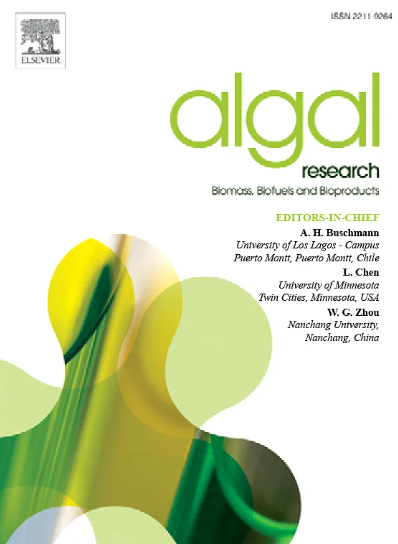潜在的商业化藻类,Coelastrella sp. SDEC-28,用于稳定生长和多种产品应用于中试规模的海水-废水培养
IF 4.6
2区 生物学
Q1 BIOTECHNOLOGY & APPLIED MICROBIOLOGY
Algal Research-Biomass Biofuels and Bioproducts
Pub Date : 2025-04-26
DOI:10.1016/j.algal.2025.104057
引用次数: 0
摘要
利用海水进行低成本的淡水微藻培养面临着局限性,因为高渗透环境限制了微藻的生长,减少了代谢物的积累。本研究将味精废水用于高值微藻Coelastrella sp. SDEC-28的海水培养。在曝气的帮助下,SMGW的生物量和脂质生产力提高了两倍,分别达到188.95和63.24 mg/L/d。这种特殊的结构有助于其胞内环境的稳定性。因此,碳水化合物、脂质和蛋白质三种代谢物在海水培养基中保持稳定,分别为28.31%、36.59%和30.52%。脂肪酸和氨基酸的概况强调了生产生物柴油和保健品的潜力。最后,SDEC-28首个1000-L微藻培养体系的建立,证明了规模化商业化生产的可行性。该研究强调了SMGW加通气作为一种具有成本效益的策略,可以提高SDEC-28的生物量和脂质产量,同时稳定代谢物,并通过1000 l的培养系统实现规模化生产。本文章由计算机程序翻译,如有差异,请以英文原文为准。

Potentially commercialisable alga, Coelastrella sp. SDEC-28, for stable growth and multiple product applications in pilot-scale seawater-wastewater cultivation
The use of seawater for low-cost cultivation of freshwater microalgae faces limitations because hyperosmotic environments restrict microalgal growth and reduce metabolite accumulation. This study applied monosodium glutamate wastewater to seawater cultivation (SMGW) for the high-value microalgal strain Coelastrella sp. SDEC-28. With the assistance of aeration, biomass and lipids productivity increased twofold, reaching values of 188.95 and 63.24 mg/L/d in SMGW. The special structure of Coelastrella contributed to the stability of its intracellular environment. Thus, three metabolites—carbohydrates, lipids, and proteins—remained stable in the seawater medium at 28.31%, 36.59%, and 30.52%, respectively. The fatty acids and amino acids profiles highlighted potential for producing biodiesel and health supplements. Finally, the establishment of the first 1000-L microalgal cultivation system for SDEC-28 demonstrated the feasibility of large-scale commercial production. This study highlights SMGW with aeration as a cost-effective strategy for boosting SDEC-28's biomass and lipids yields while stabilizing metabolites and enabling scalable production through a 1000-L cultivation system.
求助全文
通过发布文献求助,成功后即可免费获取论文全文。
去求助
来源期刊

Algal Research-Biomass Biofuels and Bioproducts
BIOTECHNOLOGY & APPLIED MICROBIOLOGY-
CiteScore
9.40
自引率
7.80%
发文量
332
期刊介绍:
Algal Research is an international phycology journal covering all areas of emerging technologies in algae biology, biomass production, cultivation, harvesting, extraction, bioproducts, biorefinery, engineering, and econometrics. Algae is defined to include cyanobacteria, microalgae, and protists and symbionts of interest in biotechnology. The journal publishes original research and reviews for the following scope: algal biology, including but not exclusive to: phylogeny, biodiversity, molecular traits, metabolic regulation, and genetic engineering, algal cultivation, e.g. phototrophic systems, heterotrophic systems, and mixotrophic systems, algal harvesting and extraction systems, biotechnology to convert algal biomass and components into biofuels and bioproducts, e.g., nutraceuticals, pharmaceuticals, animal feed, plastics, etc. algal products and their economic assessment
 求助内容:
求助内容: 应助结果提醒方式:
应助结果提醒方式:


